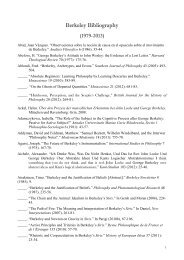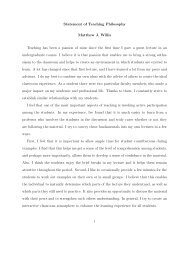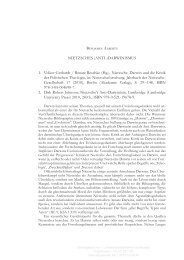12REVIEWSREVIEWSprocesses and the consequent necessity to invoke somecompensatory psychological processes. Schwartz's solution is toside-step the issue completely. He argues that it is the drawing ofthe distinction in the first place which causes the difficulty bygiving vision theorists irrelevant (and non-existent) problems tosolve - 'bogus controversies' as he calls them. His arguments areappealing. I have, however, to say that I believe he draws anunsupported conclusion when he asserts: 'much of the air shouldbe knocked out of the debates over whether ... a realist or antirealistaccount of vision is correct'. This assertion seemsunsupported because Schwartz has almost systematically avoidedbecoming engaged in any deep consideration of the ontologicalfoundations of vision, a matter I will return to in a moment.Chapter 4, and the book, concludes with an all-too-brief lookat the ontological foundations of vision theories. Given <strong>Berkeley</strong>'sown priorities, arguably the book finishes perhaps as it shouldhave begun. Schwartz makes some very valuable and evenhandedobservations on these ontological issues. For example, hestates that 'the realist thesis of a world ready-made, independentof our contribution, is no more tenable than the idea that theworld is whatever we fancy it to be'. And he notes, in passing, that'a radical subjectivist thesis is no part of <strong>Berkeley</strong>'s idealism.'Indeed as so often in the book, this is a pertinent and thoughtfulobservation which can go some way to correcting commonmisconceptions.Chapter 4 is primarily concerned with the work of Gibson, avision theorist almost as controversial as <strong>Berkeley</strong>. In thisinstance, <strong>Berkeley</strong> acts as a backdrop for Gibson and the purposeof the chapter seems to be to present an impartial and fairassessment of the merit of Gibson's position. That said, Schwartzdoes draw some very interesting parallels between the work ofthe two men, perhaps the most important being the observationthat '<strong>Berkeley</strong> and Gibson each make much of the fact that it isour experience of the visual world that is significant forbehaviour. This leads them both to emphasize the inseparabilityof seeing and doing'. This is a very instructive, for it is somethingthat so-called modern practitioners of computational vision, forexample, are now re-discovering.Although this is a valuable and enjoyable book, it is notwithout shortcomings. Perhaps the most obvious deficiency is thatit does not contain a complete and succinct summary of <strong>Berkeley</strong>'sposition as presented in the Essay Towards a New Theory ofVision. The book also misses the opportunity to rehearse theessence of <strong>Berkeley</strong>'s arguments, for these have an elegance andbeauty all of their own, irrespective of their subject matter. Toget the most out of this book, it would be essential to have firstmade a careful reading of <strong>Berkeley</strong>'s orginal text.There is another lesser shortcoming. Although Schwartzacknowledges the importance of David Marr as a contemporarytheoretician of vision, he does not address his work in anysubstantive manner. This is a pity since Marr's work has been soinfluential on modem thought on vision and it would have been
14REVIEWSinstructive to have <strong>Berkeley</strong>'s approach contrasted with Marr'sposition, if only to highlight the strength of the Berkeleiantradition.As we noted above, Schwartz does not develop in any depththe ontolological and epistemological foundations of vision.Furthermore. Schwartz's final sentence of the book leaves onefeeling disappointed. He states that 'it would seem that seriouswork in the theory of vision can best proceed by letting thesegrander metaphysical ideas float free on their own'. This is indeedregrettable if one remembers the epistemological problem withwhich we are inevitably faced when we attempt to provide anyexposition of the nature of perception, visual and otherwise. Forany attempt at such an exposition must depend on the very thingwe are investigating, namely vision! It is clear that irrespective ofhow hard it is to deal with these issues, the ontological and theepistemological concerns inevitably raise their heads and demandto be addressed. Schwartz's desire to make progress withoutaddressing them is understandable, and he is certainly not alonein this. So one must beware of singling him out for criticism.However it is unfortunate, given that perhaps <strong>Berkeley</strong>'s mostvaluable legacy was an understanding of the deepinterdependence between our perceptual processes and ourconceptions of reality.RecentPublications on <strong>Berkeley</strong>Bclfrage. Bertil. "A Response to M. A. Stewart's '<strong>Berkeley</strong>'s IntroductionDraft'", <strong>Berkeley</strong> Newsletter. 12. 1-10. 1991-92.Berman, David, (ed.). George <strong>Berkeley</strong>: Alciphron in Focus, London.Routledge. 1993.Bennan. David. "Cognitive Theology and Emotive Mysteries in <strong>Berkeley</strong>'sAlciphron" in Bennan, George <strong>Berkeley</strong>: Alciphron in Focus, 200-213.Flew. Anthony. "Was <strong>Berkeley</strong> a Precursor of Wittgenstein?" in Bennan,George <strong>Berkeley</strong>: Alciphron in Focus. 214-226.Hughes. M. "Hermes and <strong>Berkeley</strong>", British Journal for the Philosophy ofScience, 43(1), 1-19. March 1992.- Imlay Robert A. "<strong>Berkeley</strong> and Scepticism: A Fatal Dalliance", Hume Studies,18(2). 501-510, Nov. 92.-Jacob, Alexander "The Neoplatonic Conception of Nature in More, Cudworthand <strong>Berkeley</strong>" in The Uses of Antiquity. Gaukroger. Stephen (ed.)Dordrecht, Kluwer. 1991.Jesseph. Douglas M.. George <strong>Berkeley</strong> Dc Motu and The Analyst: A ModernEdition with Introductions and Commentary, Dordrecht, Kluwer AcademicPublishers, 1992.lesseph. Douglas M.. <strong>Berkeley</strong>'s Philosophy of Mathematics. Chicago.University of Chicago Press. 1993.- Kabiloglou. E. Douka. "On the Discrimination of Platonisms in EighteenthCentury England*. Philosophical Inquiry, 15(1-2) 20-45 Sep. 93.Kline, A. David, "<strong>Berkeley</strong>'s Divine Language Argument" in Berman.George <strong>Berkeley</strong>: Alciphron in Focus, 185-199.Levine, Michael and Levi. Neil. "Robinson on <strong>Berkeley</strong>:'Bad Faith' or NaiveIdealism?", Idealistic Studies, 22(2). 163-178, May 92.Levine, Michael. "How to Make a Mistake". Philosophia (<strong>Is</strong>rael), 22(1-2). 29-37, Jan. 93.- Levy, David, M. "Bishop <strong>Berkeley</strong> Exorcises the Infinite: FuzzyConsequences of Strict Finitism". Hume Studies .18(2) 5 11-536. Nov.92.- Levy, David M. "'Magic Buffalo' and <strong>Berkeley</strong>'s 'Theory of Vision': Learningin Society". Hume Studies. 19(1) 223-226 Ap.93.David VernonTrinity College DublinLievers. Menno. "The Molyneux Problem", Journal of the History ofPhilosophy. 30(3). 399-416. Jan 92.- Lucash, Frank. S. "The Nature of Mind". Ciornale di Metafisici, 13(1) 89-107.Jan-Apr. 91.Lyons, William. "Dysart Castle: George <strong>Berkeley</strong>'s Childhood <strong>Home</strong>".<strong>Berkeley</strong> Newsletter , 12. 11-15. 1991-92.
















